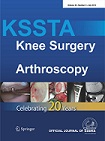
SHOULDER & ELBOW
Pain, function, and QoL similar between tenodesis and tenotomy for LHBT lesions
This report has been verified
by one or more authors of the
original publication.
Knee Surg Sports Traumatol Arthrosc. 2018 Jan;26(1):169-175
69 patients with a long head of the biceps tendon lesion and full-thickness supraspinatus tear were randomized to management of the LHBT lesion through either tenodesis or tenotomy. Patients were assessed over 24-month follow-up for function as the primary outcome, as well as pain, quality of life, range of motion, strength, cosmesis, tendon integrity on ultrasound, and complication rate as secondary outcomes. Constant-Murley scores did not significantly differ between groups at 6 months or 24 months. Secondary outcomes also did not significantly differ between groups, with the exception of a significantly higher incidence of Popeye deformity following tenotomy versus tenodesis.
Unlock the full ACE Report
You have access to {0} free articles per month.Click below to unlock and view this {1}
Unlock NowCritical appraisals of the latest, high-impact randomized controlled trials and systematic reviews in orthopaedics
Access to OrthoEvidence podcast content, including collaborations with the Journal of Bone and Joint Surgery, interviews with internationally recognized surgeons, and roundtable discussions on orthopaedic news and topics
Subscription to The Pulse, a twice-weekly evidence-based newsletter designed to help you make better clinical decisions
Exclusive access to original content articles, including in-house systematic reviews, and articles on health research methods and hot orthopaedic topics
Or upgrade today and gain access to all OrthoEvidence content for just $1.99 per week.
Already have an account? Log in


Subscribe to "The Pulse"
Evidence-Based Orthopaedics direct to your inbox.
{0} of {1} free articles
Become an OrthoEvidence Premium Member. Expand your perspective with high-quality evidence.
Upgrade Now













































































